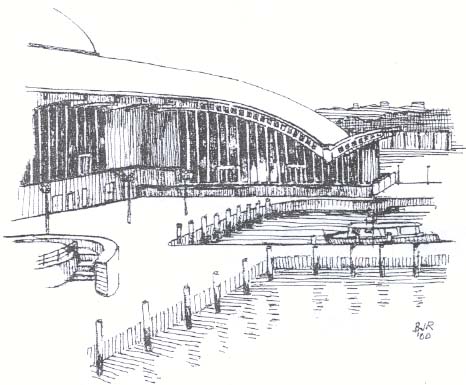 |
FAMOUS SHIPS |
 |
FAMOUS SHIPS |
The Australian National Maritime Museum
Australia has been called the world's largest island, or the island continent. It is also one of the last places on earth to be "discovered" by the European countries. When Europeans ventured at last onto the great maritime stages of the Indian and Pacific oceans, they were intent on the wealth of spices in the Indies close to the north of Australia. They gave Australia the most perfunctory of glances and largely ignored it for a century and a half - except if they were wrecked upon its low coasts because of the failure of their reckoning of latitude (more on this).
In 1787-88, 1,030 convicts, jailers, and a naval governor in eleven ships sailed 24,241 kilometers in 250 days to establish a prison settlement in southeastern Australia. When the ships sailed back to England, the people left behind had to depend on the sea for survival. They were restricted, however, to build boats larger than fourteen feet on the keel both to keep the convicts from escaping and to protect the British East India Company's monopoly on Far Eastern trade.
The colony’s first industries were the maritime ones of whaling and sealing, and the port of Sydney where the National Maritime Museum is located drew much of its early prosperity from servicing the international fleets of whalers - American, French, British that roamed the Pacific during the early 19'h century.
The Australian
National Maritime Museum is the only national museum to be located outside the
capital of Australia, Canberra. However, its place in Sydney, the nation's
oldest European settlement and port, is unarguable - and it is unarguably one of
the great museum sites in the world. Located at Darling Harbor, an arm of Sydney
Harbor adjoining the central business district, the museum is at once part of
the working port and part of an ambitious new urban renewal scheme that has
created a major waterfront recreational area. The museum building, with its
soaring steel-and-glass exhibition halls and the wharves for its varied
collection of historical Australian vessels, has become a Sydney landmark.
As far as ship models go, they have a few excellent models on display. There is a large model of the Endeavour, Captain Cook's ship. There is also an excellent open plank-on-frame model of an early Dutch ship, along with several more modem models of passenger ships and warships of the Australian Navy.
There are also several ships located at the museum. The replica of Captain Cook's Endeavour is there - I had the pleasure of going aboard her. It is very interesting that this ship has all the modern navigational and power requirements for a ship - engine, radar, etc., but still looks and can sail like the old sailing ship of earlier times. A modem Australian Navy WWII destroyer is there, along with a Russian submarine, a light ship, etc.
The most interesting ship for me was the Dutch East Indiaman BATAVIA of 1628. This ship is the next best thing to a pure ship of the 15th century. She has no engine, no navigational aids of any kind. She is strictly a sailing ship built exactly like she was so many years ago. She was built in Lelystad on the shores of the Markermeer in the Netherlands in the 1980's and launched in 1995. She was brought to Sydney piggybacked on a semi-submersible dock ship, since she was not allowed to' sail by herself across the seas by today's standards.